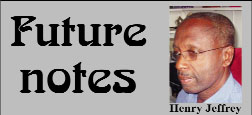Across the political divide, after a year in office, the populace appears to have given up any expectations that, with the exception of national elections sometime soon, much will result from the presidency of Mr. Donald Ramotar. What is even more surprising is that in this era of media politics, when many political operatives have made their stock in trade the appearance of being on top of their agenda while doing little to create or advance it in a sensible manner, even here President Ramotar’s contribution has not been sterling. Indeed, it is as if he simply cannot devise and project a schema to catch the public imagination.

Many in the PPP/C, perhaps the current president himself, recognising the level of disgruntlement among its supporters as elections drew near, began to sell the notion of radical changes if the party won and was able to form a new government. Unfortunately, to the chagrin of many ranging from the Kaieteur News to Joey Jagan, no such changes have occurred. These many are now complaining that they were mesmerized by the perfect bad cop good cop play of the Jagdeo/Ramotar tag team. Thus, Mr. Ramotar’s incapacity to now project a more compelling image is rooted in the part he played in the old system and the nature of our expectations. He simply cannot appear credible unless he is prepared to first denounce what the public view as some of the more blatant recent PPP/C transgressions and neither he nor his party recognise this because he was an intricate part of the tag team and the others were willing bit players.
It is in the nature of politics, and particularly presidential politics, for the president to be the focus of attention and this tendency has also crept into parliamentary type politics. This is not unreasonable since it is the president who appoints and disappoints: makes the final decisions and must take the final blame. As a result, the media and the disgruntled public persistently blamed former President Jagdeo for all that was initiated and done during his regime without recognising that Guyana is not a normal country. They failed to see the play and even understand that President Jagdeo was not chosen or elected in a normal fashion. He was, more or less, selected by a Janet Jagan-led cabal and elected in what some like to call an ethnic referendum and in retrospect it was extremely foolish to believe, particularly when Janet Jagan was alive, that he would not have had to get the compliance of that cabal for much of what he was doing!
But in seeking to fool the public the PPP/C also fooled itself. For, had it recognised the above context there are many issues – a resolution of the national cricket situation, allowing arbitration for the bauxite workers, taking a more accommodative approach to the tripartite discourse and budget process, etc. – that could have given at least the impression of a substantial departure and thus open some space for many to view the incumbent more sympathetically and succumb to areas of policy continuances. Instead, what the PPP/C has encouraged is simply more of the same coupled with political dissension, the latter in the hope of regaining lost political support.
However, if this explains why there is no denunciation of past policies, it certainly is not the entire story of why this president comes over as a damp squib. The mind-set of the current incumbent is also a contributing factor, and his recent presentation to the congress of the Women’s Progressive Organisation, which is being widely criticised in opposition circles, simply brought to bear on modern reality the traditional PPP narrative with all its half truths and exaggerations.
As usual, the PNC – now APNU – is the whipping boy and has been criticised for changing its name to improve its electoral chances, notwithstanding that in 1992 the PPP did the self-same thing. According to a report, the president claimed that the PNC took “Guyana from the most developed country in the English-speaking Caribbean to the most “backward” one by 1992” (“Ramotar says PPP/C has no confidence in Trotman:” SN: 27/11/2012). Of course, as one who has studied economics, he must have known that such an assertion was untrue. As the following numbers indicate, Guyana was far from being the most developed English-speaking Caribbean country in 1964 and, indeed, was poorer in 1964 than it was in 1961.
GDP (GDP per capita, Current US$)
Word Bank Indicators
This is not surprising since Western capitalist interest was at the time doing everything it could to stymie all of the PPP’s efforts, making the early Jagan period, at best, one of stagnation. It is understandable that one of the tactics the PPP used to hold on to its supporters during nearly three decades in the political wilderness, was to paint its first period in government as being halcyon days of Guyanese development. And it is also true that under the PNC, Guyana’s economy and society was effectively ruined. However, as I have argued on many occasions, there is sufficient blame to go around and upon which both parties should ponder.
The task of a president in the second decade of the 21st century is not to regurgitate a distorted bygone narrative but to weave and try to sell an ideological tapestry that is likely to unite and lead to national development. In my view, the failure of the PPP/C to recognise the context presented in the first part of this article, coupled to the archival narrative of the president (and his party) makes it difficult for him to excite the public mind.
henryjeffrey@yahoo.com






